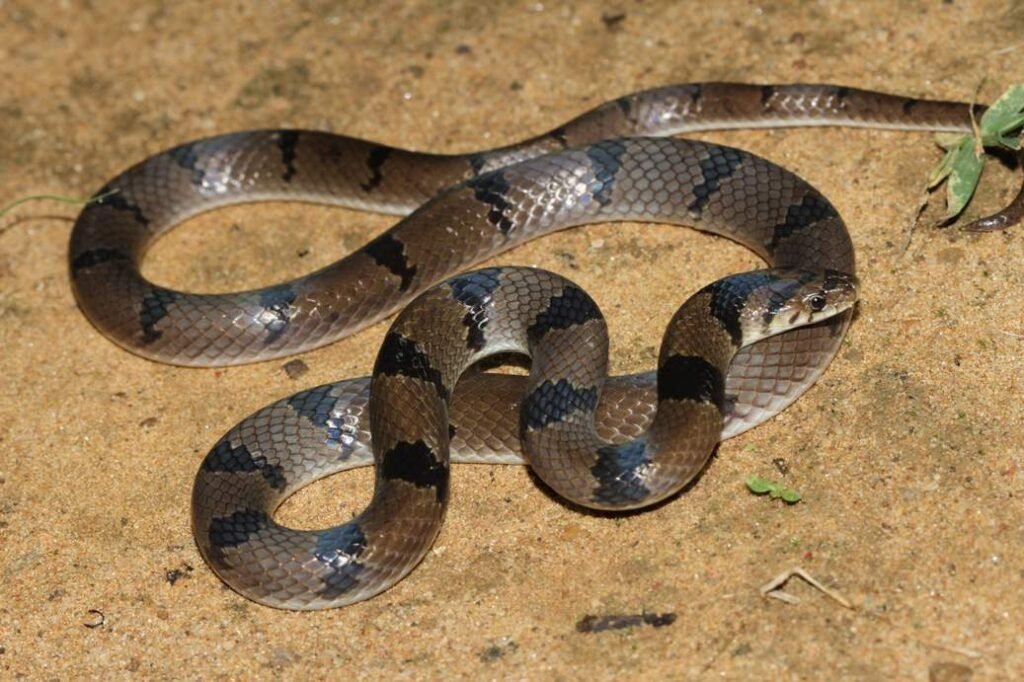Introduction about Banded Kukri Snake
The Banded Kukri Snake is one of the lesser-known, yet fascinating snakes found in parts of Asia. It belongs to the Colubridae family, which includes mostly non-venomous species. This snake gets its name from the shape of its teeth, which resemble the traditional Nepali ‘kukri’ knife. Though it may appear intimidating to some due to its vivid bands and fast movements, the Banded Kukri Snake is harmless to humans and plays an important role in maintaining ecological balance by controlling the populations of small prey like lizards and rodents. At WildlifeNest.com, we aim to bring awareness to such remarkable reptiles that are often misunderstood. This species thrives in a variety of habitats and is known for its secretive behavior, usually hiding under rocks, leaf litter, or burrows. Despite its relatively small size and non-aggressive nature, the Banded Kukri Snake displays a striking beauty that makes it a favorite among herpetologists and snake lovers alike.
Banded Kukri Snake

Species Profile: Banded Kukri Snake
| Feature | Details |
|---|---|
| Snake Name | Banded Kukri Snake |
| Scientific Name | Oligodon arnensis |
| Wild Life Protection Act | Schedule IV (India) |
| Regional Names | Hindi – Pattewala Saap, Marathi – Patta Saap, Tamil – Vattam Pambu, Kannada – Chitte Haavu |
| Physical Description | Slender body, alternating dark and light bands, round pupils, average length 30–60 cm. |
| Habitat | Forests, farmlands, rocky hills, and scrublands. |
| Diet | Primarily reptile eggs, small lizards, insects. |
| Behaviour | Nocturnal, shy, ground-dwelling, burrower. |
| Venomous or Non-Venomous | Non-Venomous |
| Venom Type | Not applicable |
| Venom Effects on Prey | Not applicable |
| Venom Effects on Humans | Harmless, does not bite unless provoked |
| Common or Rare Species | Fairly common in Indian subcontinent |
| Life Span | 6–10 years (estimated in wild) |
| Mating & Reproduction | Oviparous; lays 3–7 eggs during summer |
Introduction to Snakes of Banded Kukri Snake
Snakes like the Banded Kukri Snake share common reptilian characteristics such as scaly bodies, ectothermic (cold-blooded) metabolism, and unique skeletal flexibility that allows them to consume prey larger than their head. The anatomy of kukri snakes is particularly interesting due to their specialized rear teeth shaped like a kukri knife. These specialized teeth allow them to slice open reptile eggs and consume the contents, which is their preferred diet. These snakes do not possess venom glands, unlike some of their more dangerous cousins.
In the broader ecosystem, snakes like the Banded Kukri play a vital role by controlling the population of pests and maintaining balance. Without such reptiles, rodents, insects, and other small creatures would reproduce unchecked, disrupting food chains and affecting human agriculture. Sadly, due to fear and myths, many people kill snakes on sight. It’s important to know that most snakes are harmless and even beneficial to the environment.
There are many misconceptions about snakes—some believe they chase people or drink milk, which are pure myths. Education and awareness are essential to change such beliefs. Through platforms like WildlifeNest.com, we strive to help people understand and appreciate the real nature of snakes like the Banded Kukri.
Habitat and Distribution
Banded Kukri Snakes are highly adaptable and can thrive in a variety of natural habitats. They are primarily found in forested regions, but they are also known to inhabit agricultural lands, scrublands, rocky terrain, and even human settlements where prey like lizard eggs and insects are abundant. These snakes prefer hiding under rocks, leaf litter, or inside burrows during the daytime and come out during the night to hunt.
Geographically, the Banded Kukri Snake is widely distributed across the Indian subcontinent. It is found in India, Sri Lanka, Bangladesh, Nepal, and parts of Pakistan. In India, their presence is noted in several states including Maharashtra, Tamil Nadu, Karnataka, Madhya Pradesh, and Odisha. Their broad distribution is a testament to their adaptive nature and secretive lifestyle. These snakes are not limited to one altitude and can be found from plains up to moderate elevations in hills.
| Habitat Type | Details |
| Forests | Moist deciduous and dry deciduous forests |
| Deserts | Rarely found; prefers more humid or wooded areas |
| Wetlands | Occasionally found near water bodies |
| Agricultural Areas | Frequently seen due to abundance of eggs and insects |
| Rocky Hills and Scrublands | Ideal for burrowing and hiding under stones |
| Geographical Range | Presence |
| India | Common in various states |
| Sri Lanka | Native species |
| Nepal | Widely distributed |
| Bangladesh | Reported in several regions |
| Pakistan | Less common, but occasionally spotted |
Snake Behaviour
The Banded Kukri Snake displays a shy and reclusive nature. They are primarily nocturnal and are rarely seen during the day unless disturbed. Their behavior is non-aggressive, and when threatened, they usually try to flee rather than confront. Unlike venomous snakes, they rely on their agility and camouflage to stay hidden from predators.
In terms of feeding habits, Banded Kukri Snakes are specialized egg eaters. Their kukri-shaped teeth help them slice open reptile eggs, a diet that is quite unusual among snakes. They may also consume small lizards and insects occasionally. These snakes are ground dwellers and are frequently found under rocks, in burrows, or amidst fallen leaves.
Mating generally occurs during the warmer months. Males compete for females, and after mating, the female lays 3 to 7 soft-shelled eggs in a secure location like under rocks or loose soil. The young hatch after about 40 to 60 days and are independent from birth.
Their defense mechanisms do not include venom or elaborate displays. They may release a foul-smelling musk if threatened. Occasionally, they may feign a strike, but bites are rare and non-threatening.
First Aid and Medical Treatment for Banded Kukri Snake Bites
Although the Banded Kukri Snake is non-venomous and considered harmless to humans, people may sometimes suffer minor injuries due to defensive bites if the snake feels cornered. These bites are superficial and typically result in minor scratches.
First Aid Steps:
- Clean the Wound: Wash the bite area thoroughly with soap and water.
- Disinfect: Apply antiseptic solution to prevent infection.
- Monitor for Infection: Check for signs of swelling or redness. If any symptoms persist, consult a doctor.
- Avoid Panic: Since the bite is non-venomous, there is no need for antivenom.
Medical treatment may include a tetanus shot or antibiotics if there’s a risk of infection, but hospitalization is generally unnecessary. At WildlifeNest.com, we encourage awareness so people can differentiate between venomous and non-venomous species to reduce unnecessary panic.
Global Impact of Banded Kukri Snake Bites
There is negligible global impact caused by Banded Kukri Snake bites. These snakes are non-venomous and not aggressive toward humans. Any interaction is generally harmless. However, because they resemble some venomous species, people may react with fear and kill them, which negatively impacts local ecosystems. It’s vital to spread awareness about their harmless nature.
If You Encounter a Snake on Your Property
- Remain Calm and Assess the Situation: Don’t panic; most snakes, including Banded Kukri, are non-threatening.
- Ensure Safety: Keep pets and children away and don’t try to handle the snake.
- Identify the Snake (If Possible): Try to visually observe from a distance. Avoid assumptions.
- Contact Professional Help: Call a local wildlife rescuer or forest department.
- Prevent Future Encounters: Seal holes, clean surroundings, and avoid storing firewood inside homes.
- Educate Yourself and Others: Awareness reduces fear and helps protect both people and snakes.
Tips for Snake Enthusiasts
- How to Safely Observe Snakes in the Wild: Use binoculars and maintain a respectful distance. Avoid sudden movements. Early morning or dusk is best for sightings.
- Tips for Aspiring Herpetologists: Read field guides, attend workshops, join wildlife clubs, and practice responsible photography and documentation. Always prioritize the safety of both the observer and the reptile.
Interesting Facts about Banded Kukri Snake
- The Banded Kukri Snake has unique teeth that can cut through tough reptile eggshells, something not many snakes can do.
- Despite its bright banding which resembles some venomous snakes, it’s completely harmless and prefers to avoid confrontation.
- It can mimic a strike to scare off predators even though it rarely bites.
- The snake is excellent at hiding and often remains unnoticed even in populated areas.
- When handled, it may release a foul-smelling substance from its cloacal glands as a defense tactic.
- These snakes play an important role in controlling reptile populations by consuming eggs.
- Juveniles hatch fully developed and ready to survive without any parental care.
- They are also known to have excellent memory for burrow locations and return to the same shelter.
- Though small in size, they are agile and fast-moving, making them hard to catch.
- Their presence is a sign of a healthy, biodiverse ecosystem.
Stay connected with www.WildlifeNest.com for more amazing facts and stories about the wonderful world of snakes and other wildlife!
Frequently Asked Questions (FAQs) about Banded Kukri Snake
Q1. Is the Banded Kukri Snake dangerous to humans?
No, the Banded Kukri Snake is completely harmless to humans. It is non-venomous and rarely bites unless provoked.
Q2. Why is it called a Kukri Snake?
The snake is named after its kukri-shaped rear teeth, which resemble the traditional Nepali kukri knife. These teeth help it slice open reptile eggs.
Q3. Where can I commonly find Banded Kukri Snakes in India?
They are commonly found in forested areas, agricultural fields, and rocky regions across Maharashtra, Tamil Nadu, Karnataka, and several other states.
Q4. What does the Banded Kukri Snake eat?
Its diet mainly includes reptile eggs, small lizards, and insects.
Q5. How can I differentiate it from a venomous snake?
The Banded Kukri Snake has round pupils, no hood, and a small head, which are general signs of non-venomous snakes. However, always observe from a safe distance and consult experts if needed.
Q6. What should I do if I see a Banded Kukri Snake near my house?
Do not panic. Avoid disturbing it and contact local wildlife authorities or rescue groups for safe relocation.
Watch Wildlife Awareness Videos
For more engaging and educational content on snakes and other wild creatures, don’t forget to visit our official YouTube channel: www.youtube.com/@WildlifeNest
Subscribe and explore fascinating wildlife stories, awareness videos, and rare sightings—all brought to you by Wildlife Nest!
Related Snake Species – Explore More on Wildlife Nest
| Snake Species / Topic | Read Article |
|---|---|
| Indian Rat Snake | Read Article |
| Common Sand Boa Snake | Read Article |
| Indian Rock Python | Read Article |
| Two Step Snake | Read Article |
| King Cobra Secrets – Study Breaks 180 Year Myth | Read Article |
| Slender Coral Snake | Read Article |
| The Green Vine Snake – An In-Depth Look | Read Article |
| Common Cat Snake – All Information | Read Article |
| Banded Krait Snake – All Information | Read Article |
| King Cobra – All Information | Read Article |
| Common Krait – All Information | Read Article |
| Russell’s Viper | Read Article |
| Saw Scaled Viper Snake – All Information | Read Article |
| Cobra Snake – All Information | Read Article |
| The Big Four Snakes of India | Read Article |
| What Are Reptiles? | Read Article |
| The Deadliest Venom | Read Article |
| Most Dangerous Snakes in the World | Read Article |
| The Ultimate Guide to Snakes | Read Article |
| History of Snakes – Evolution, Habitats, Survival | Read Article |


